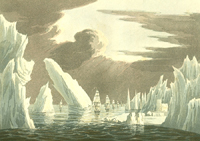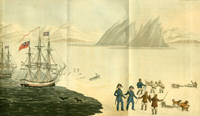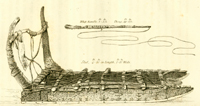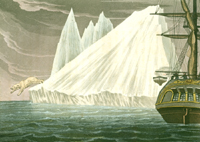|
Exhibition Links
|

A Voyage of Discovery, Made Under the Orders of the Admiralty, in His Majesty's Ships Isabella and Alexander, for the Purpose of Exploring Baffin's Bay, and Inquiring into the Probability of a North-West Passage. London, 1819. [Rare Books Division]
Ross's voyage resurrected the British government's quest for a Northwest Passage through the Arctic after a two-hundred-year hiatus. A seaman since his teenage years, Ross gained his experience in a number of naval engagements over a wide range of territory: the Mediterranean, Caribbean, Baltic, North Sea, South Atlantic, and White Sea. At the age of forty, he accepted without hesitation the assignment to command the Admiralty's expedition. In addition to discovering a passage to the Pacific, Ross's secondary object, outlined in his official orders, was the improvement of the geography and hydrography of the Arctic Regions, of which so little was known.
As commander, Ross was offered a salary of £46 per month, able seamen £3. The selected ships, Isabella (385 tons) and Alexander (252 tons), underwent strengthening and reinforcing improvements inside and out; their combined twenty-six month food allowance included over fifteen tons of bread, eight tons of beef in eight-pound pieces, 3500 pounds of lemon juice, and 1000 pounds of raisins. The Isabella carried an assortment of scientific instruments and a library of the published journals and accounts of earlier expeditions, such as those of Hearne, Mackenzie, Ellis, and Cook. Among items intended as gifts to natives on the west coast of Greenland and the coast of America were: 2000 needles, 200 looking-glasses (mirrors), 30 pairs of scissors, 150 pounds of soap, 102 pounds of snuff, 129 gallons of English gin, and 40 umbrellas. Accompanying Ross and his crew as an interpreter was John Sacheuse, a native of Greenland who, having been saved in a storm by an English ship several years before, had learned English and converted to Christianity.
On 18 April 1818 the ships departed; less than seven months later, they were back in the Shetlands, and Ross reported to the Admiralty in London on November 16. Generally, Ross's route had duplicated Baffin's of 1616: a counter-clockwise circumference of Baffin Bay. They had sailed up the west coast of Greenland, reaching a latitude just above 77° N. Interactions with the natives, whom Ross called “Arctic Highlanders” and serious encounters with ice and icebergs had been the highlights of their journey. Unfortunately, after proceeding a few degrees into Lancaster Sound, Ross turned the ships back out of the “bay,” claiming that he could see their way blocked by ice and what he named Croker Mountains [see image and map]. This was the defining moment of the expedition, and their arrival back in England caused a considerable public controversy, for other officers, particularly those aboard the Alexander, felt a great opportunity had been lost because of an unsubstantiated observation. Ross was lampooned [see Cruikshank print] and lost favor with John Barrow in the Admiralty. Ross himself felt that one of his voyage's major achievements had been the re-confirmation of William Baffin's geographical observations and the subsequent restoration of Baffin to a lofty place in the history of Arctic exploration:
In re-discovering Baffin's Bay, I have derived great additional pleasure from the reflection that I have placed in a fair light before the Public, the merits of a worthy and able Navigator [William Baffin]; whose fate, like that of many others, it has not only been, to have lost, by a combination of untoward circumstances, the opportunity of acquiring during his life-time the fame he deserved; but, could he have lived to this period, to have seen his discoveries expunged from the records of geography, and the bay, with which his name is so fairly associated, treated as a phantom of the imagination. [Ross, p. iii.]
Ross's heavily illustrated expedition journal, with appendices full of zoological [see sample bird entry], geological, and geographical data, became a model publication for subsequent British expeditions.




